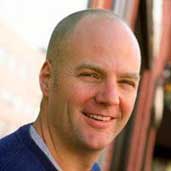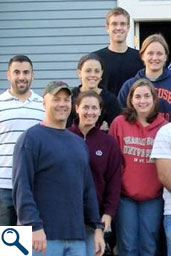| |
What went wrong?
In October 2004, Merck & Co, one of the largest pharmaceutical companies in the world,
issued a recall on Vioxx® (rofecoxib), one of their best-selling drugs. Vioxx is a pain-killer
used to treat rheumatoid arthritis. It didn’t cause stomach pain the way
some the other drugs did, but just five years after it entered the market, Merck stopped selling it.
Why? Vioxx also greatly increased the risk of heart attack. in patients. The recall left many people wondering,
‘How could the Food and Drug Administration (FDA) approve a drug with such harmful side effects?’
One answer is that if the drug were to be approved in any reasonable length of time, the FDA would
not have known about any heart-related symptoms because it would take too long. There is currently
no way to test drugs for their effects on the heart prior to approval.
Recently, researchers at Harvard University have come one step closer to making heart testing possible.
Researchers in Dr. Kevin Kit Parker’s lab have found a way to actually grow heart muscle in a Petri dish.
In the future, pharmaceutical companies could test their drugs on heart muscle before putting them on the
market. In this way, they would be able to know of any potential heart complications with the drug before
any patient had a heart attack.
How muscle works
From insects to elephants, all animals have muscles. There
are different types of muscle, but they all work essentially
the same way. Muscle cells are made of many tiny fibers that
all align in the same direction. They are called motor proteins
because they are capable of movement.
A car that will only work if it has gasoline; muscle fibers can only move if they have energy. That energy
comes from sugar. Your body breaks each molecule of sugar down into six molecules of adenosine triphosphate,
or ATP. You can think of ATP as a unit of energy. Indeed, one molecule of ATP can move a muscle cell 5 nanometers,
or .000000005 meters. That is a very small distance, but your body makes billions of molecules of ATP per day.
The motor proteins in a cell use these molecules of ATP to move.
So how does this technology work? How can something as unique
as muscle be made in a lab. Researchers, led by Dr. Adam
Feinberg in Dr. Parker’s lab began with a thin plastic film. The film can bend, stretch and twist.
The idea is to grow muscle cells on the film.
To start the process, Dr. Feinberg and his team printed proteins
onto the film. They did this in the same way that you rubber
stamp an image on paper. By printing the proteins, the researchers
could control the shape and direction in which the muscle
grows. The protein they printed on the film was fibronectin.
Fibronectin is in a class of proteins called extra-cellular
matrix proteins similar to collagen,
which you may be familiar with. The function of these proteins
is complex, but can be thought of simply as the glue that
holds cells together. On top of the fibronectin, researchers
grew heart muscle cells, called cardiomyocytes. “The cardiomyocytes
we used come from animal heart tissue,” said Dr. Feinberg, “but
some day we may be able to use human heart tissue instead.”
The cardiomyocytes are
incubated and grown to full size in four days. You can think
of the final film as a sandwich of plastic film, fibronectin,
and cardiomyocytes.
From this film strip, researchers can then cut any shape
they wanted. One of the most useful shapes to demonstrate
the ability of these muscle films is an isosceles
triangle. If
you have taken geometry, you will remember that an isosceles
triangle has two equal sides. In this isosceles triangle,
the two equal sides were very long and the base was short.
When the muscle cells shorten in length (we call this contraction),
the pointy tip of the triangle film bends more than the base.
Then when it relaxes, the triangle tip snaps back into place
like a tail flapping, propelling the film forward through
the water. In a way Dr. Feinberg and his team created a rudimentary
model of a fish. What good is a human-constructed fish? The
fish is just an example to see how the technology works. “As far
as medicine is concerned,” said
Dr. Feinberg,
“the possibilities are infinite.”
Here are just a few examples of some future projects using the thin film technology:
Researchers could create diseased heart muscle, like the heart muscle in someone with high blood pressure, to
compare with healthy heart muscle. Then pharmaceutical companies could test the effects of their medications in
healthy patients as well as patients who already have a heart condition such as high blood pressure. This could
prevent another Vioxx-like drug recall. Researchers could also use the diseased tissue to figure out how to make
it healthy again. In other words, this technology could eventually be used to find a cure for heart disease.
It is also possible to grow other types of tissues. For example, instead of growing heart muscle, researchers could
grow vascular smooth muscle that is found it the arteries. This type of film could be used to find remedies for
all sorts of vascular diseases such as hypertension or high blood pressure. Skin cells could also be grown using this
type of technology and used for grafting after severe burns. “This is just the beginning,” said Dr. Feinberg.
“There are endless ways in which we can use this technology to better people’s lives.”
Dr. Adam Feinberg is a post-doctoral research fellow in Dr. Kevin Kit Parker’s lab at Harvard University. He was the
lead investigator of the thin films technology. Dr. Feinberg is a materials engineer with an interest in biomaterials.
His interests have led him to integrate biology, chemistry and physics in his work. He would like to understand how
the human body responds to artificial materials.
|
|

Kevin Kit Parker, Ph.D.

Group Retreat Photo
Sign Up for our Monthly Announcement!
...or  subscribe to all of our stories! subscribe to all of our stories!

What A Year! is a project of the Massachusetts
Society for Medical Research.
|
|

